Top 8 tag management systems (TMS) and how to choose one
You most likely deploy dozens of tracking tags across your websites and apps. Analytics scripts, advertising pixels, personalization tools, and consent trackers all compete for space in your code. Managing them manually can create bottlenecks, slow down launches, and risks breaking your site.
A tag management system (TMS) can solve this problem by providing you with control over when, where, and how your tags fire. You can deploy new tracking without waiting for developers, test changes safely, and more easily comply with privacy regulations.
There are many tag managers available either as sole products or as features of larger analytics packages. We compared 8 leading tag management systems to help you choose the best one for your needs.
Key takeaways
- Tag management systems (TMS) streamline tracking tag deployment and management, increasing marketing teams’ agility, enabling faster deployments, and improving site performance.
- Key TMS features include code-free deployment, integrations, debugging, and consent controls.
- Top TMS include Google Tag Manager, Adobe Experience Platform Launch, Tealium iQ, and Piwik PRO.
- Solutions like ObservePoint, Ingest IQ, TagCommander, and Yottaa offer specialized tag management functionality.
- Choosing a TMS depends on existing tech stack, budget, team capabilities, regulatory needs, and growth plans.
- Enterprise TMS provide advanced governance and compliance features, while basic solutions prioritize simplicity.
Our top picks for tag management solutions
| Tag management system | Core features | Price |
| Google Tag Manager | Code-free tag deployment, strong Google integrations | Free (core features) Enterprise pricing available via quote |
| Adobe Experience Platform Launch | Deep Adobe Experience Cloud integration, enterprise governance | Included with Adobe Experience Cloud (no standalone pricing) |
| Tealium iQ | Universal data layer, 1,300+ vendor integrations | Custom pricing |
| Piwik PRO Tag Manager | Consent-first design, flexible hosting options | Business plan from EUR 35/month Enterprise plan from EUR 366/month |
| ObservePoint | Automated tag and consent audits | Free trial (up to 1,000 pages) Paid plans scale with volume |
| Ingest IQ | Server-side tag deployment, real-time monitoring | Custom pricing |
| TagCommander | Consent integration, CDP connectivity | Custom pricing |
| Yottaa | Third-party tag control, site speed optimization | Free plan available Paid plans from ~USD 12K/year |
How do tag management tools work?
Tag management systems simplify the addition and maintenance of tracking codes, aka tags, on websites and apps. Instead of editing code directly, teams use a single container tag that connects to a management interface. From there, they can add, update, pause, or remove individual tags without deploying new code each time.
When a page loads, the container tag triggers the right set of marketing, analytics, or personalization tags according to the rules you define. Many platforms also include debugging tools, version control, and consent logic, all of which help tags fire correctly and according to legal requirements.
Benefits of tag management systems
The focus of tag management is on control and efficiency. Instead of hard-coding tags across dozens of pages, you manage them from a unified, central platform. That means fewer developer dependencies, faster deployment, more streamlined updates, and less risk of breaking your site.
Tag management solutions also improve performance. They streamline how tags load, which reduces page weight and improves site speed. That’s an improvement both users and search engines value.
A tag management system also gives your team greater agility. Marketers can launch campaigns or update tracking without waiting on release cycles, while developers spend less time on repetitive tagging tasks.
Finally, there’s the benefit of governance. With version control, user permissions, and built-in testing tools, tag managers help organizations maintain accuracy and support privacy compliance as their data needs grow.
The 8 best tag management systems
We assessed eight of the top tag management systems on the market. We scoured user reviews and considered key features for tag management, breadth of integrations, and additional options offered.
Google Tag Manager
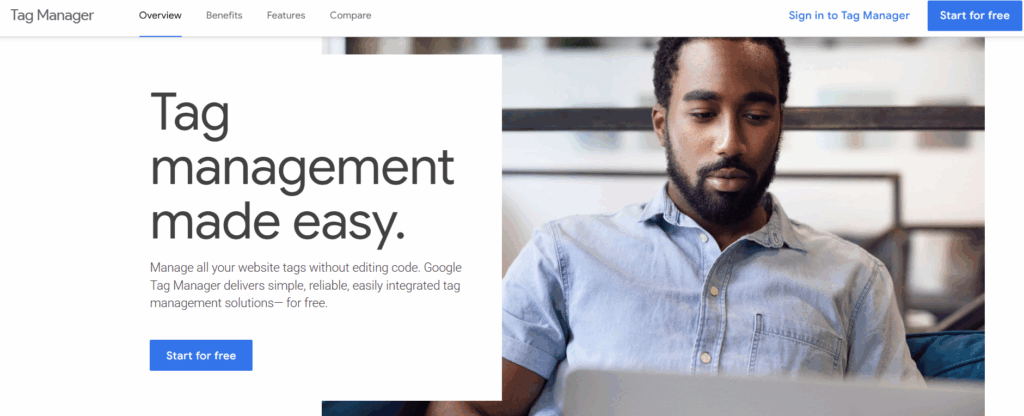
Google Tag Manager (GTM) is one of the most widely used tag management systems. It’s designed to simplify how tags are added and updated on websites and apps.
Instead of editing site code directly, teams can manage everything from within the GTM interface, which reduces developer involvement and speeds up deployment.
GTM integrates natively with Google products like Analytics and Ads, but also supports third-party and custom tags. That’s why it is often the go-to solution for organizations that want flexibility without cost.
Key features
- Code-free deployment: Add, update, and disable tags through an intuitive interface, without the need for ongoing developer support.
- Built-in templates: Preconfigured tag templates for Google and third-party tools make implementation faster and less error-prone.
- Collaboration tools: Workspaces, version history, and granular permissions enable multiple team members to work in parallel.
- Error checking and debugging: Integrated preview mode and error detection help ensure tags fire correctly before going live.
Pricing
- Free tier: Fully functional, no cost
- Enterprise (Tag Manager 360): Available with Google’s Analytics 360 suite. Pricing is available by request.
| Pros | Cons |
| No cost for core features | May lack advanced enterprise features |
| Easy to learn and deploy | Initial setup may require technical assistance |
| Strong support for Google tools and templates | Advanced customization can be limited |
Adobe Experience Platform Launch
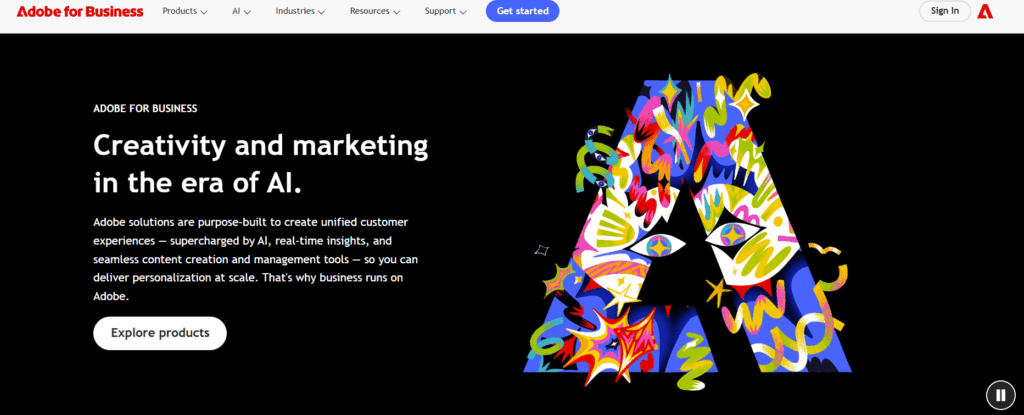
Adobe Experience Platform Launch (commonly referred to as Adobe Launch) is Adobe’s enterprise-grade tag management solution. It replaced Adobe’s older Dynamic Tag Management product.
Adobe Launch is built to work seamlessly with the Adobe Experience Cloud, making it a natural fit for organizations already invested in Adobe’s marketing, analytics, and personalization tools.
Its governance features and extension-based architecture give enterprises greater control and flexibility, but its complexity may be unnecessary for smaller teams.
Key features
- Deep Adobe integration: Works natively with Adobe Analytics, Target, Audience Manager, and other Experience Cloud products for smooth data flow.
- Extension-based setup: Tags are packaged as extensions that can be installed, configured, and updated, streamlining deployment across vendors.
- Enterprise governance: Strong role-based permissions, publishing workflows, and audit trails support large, distributed teams with strict compliance needs.
- Third-party support: While it is Adobe-first, Launch also supports integrations with non-Adobe vendors, keeping it flexible for broader marketing stacks.
Pricing
Adobe Launch’s pricing is integrated into Adobe’s Experience Cloud, and it is not available as a standalone product. However, there is no additional charge for it if you are an Experience Cloud customer.
| Pros | Cons |
| Powerful with Adobe integration | No standalone pricing, and a subscription may be costly for smaller teams |
| Flexible and extensible | Steeper learning curve |
| Robust for enterprise tagging | Can be excessive for simpler setups |
Tealium
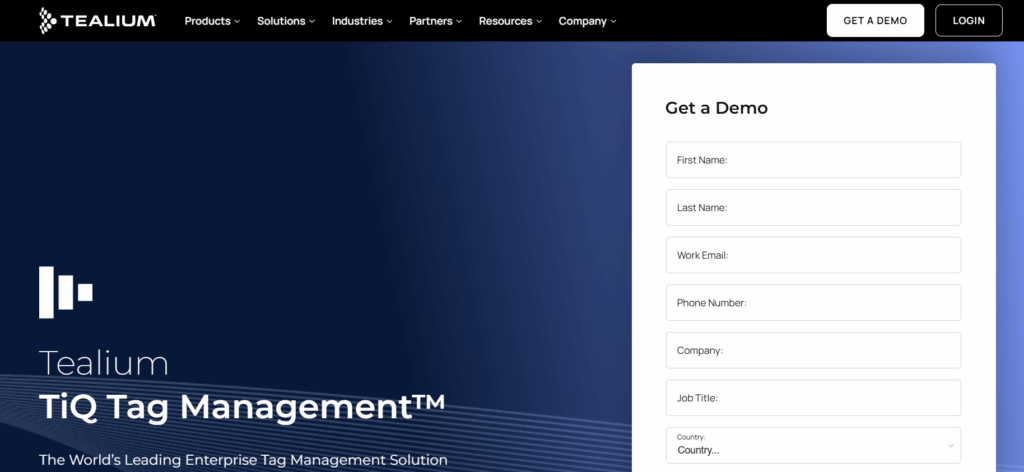
Tealium iQ is part of Tealium’s broader Customer Data Hub. It’s a popular choice for enterprises that want advanced control over how data is collected, processed, and shared with vendors.
Some systems primarily focus on firing tags, but Tealium iQ also emphasizes data governance, privacy, and compliance. Its global delivery network helps tags load quickly across geographies, while the extensive integration marketplace makes it one of the most adaptable solutions available.
Key features
- Universal data layer: Establishes a consistent structure for collecting and sharing customer data across platforms, reducing discrepancies between tools.
- Vendor marketplace: Access to over 1,300 vendor integrations, requiring fewer custom setups and faster time-to-value.
- Privacy and compliance controls: Built-in features to manage data access and restrict vendor usage help align with regulations like the GDPR and CCPA.
- Robust infrastructure: The platform uses a global, multi-content delivery network (CDN) architecture to support high availability and minimal impact on site performance.
- Team collaboration: Role-based access control, audit trails, and version histories provide enterprise-grade change management.
Pricing
Tealium’s pricing is not publicly available. Interested parties need to contact Tealium for a custom quote.
| Pros | Cons |
| Fast, reliable tag delivery | No transparent pricing |
| Strong data governance and privacy that are tied to regulations | May excessive for smaller companies |
| Large integration ecosystem and flexible deployment |
Piwik PRO Tag Manager
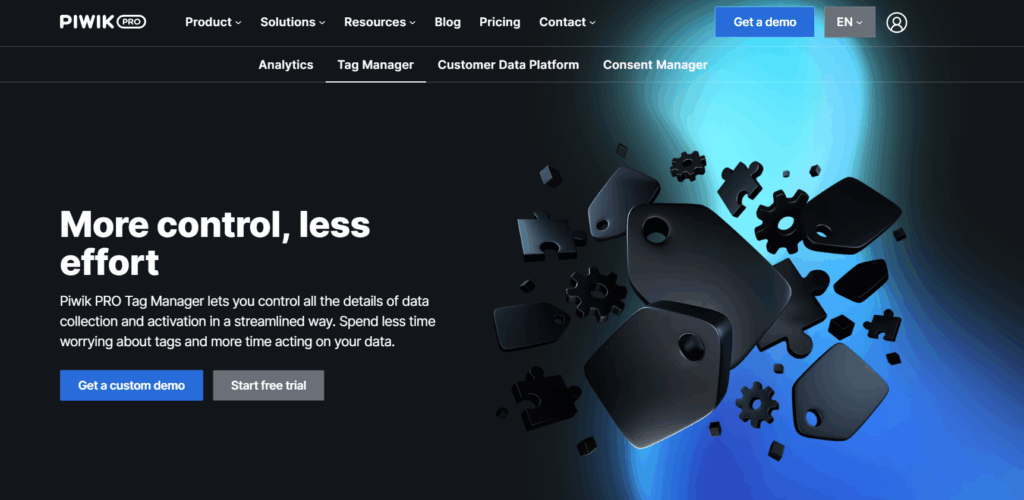
Piwik PRO Tag Manager is part of the wider Piwik PRO Analytics Suite. It offers a privacy-focused alternative to mainstream tools.
Piwik PRO blends tag deployment with consent management and data control. It’s designed for industries that need to balance a need for rich insights with tight requirements for regulatory compliance. Hosting is available within the EU or via private cloud options, so organizations have control over where data lives and how it’s managed.
Key features
- Template-rich and flexible: The solution comes with comprehensive tag, trigger, and variable libraries, plus the ability to craft custom tags with JavaScript.
- Consent-first design: It integrates directly with the Piwik PRO Consent Manager to ensure tags fire only with proper authorization.
- Strong data control: With support for cloud, private cloud, and on-premises hosting, Piwik PRO keeps your data within the hosting environment you select.
- Debugging and QA tools: Includes test environments and debug modes to catch misfires before they go live.
Pricing
- A 30-day free trial is available
- Business Plan: Starts at EUR 35/month, and includes Analytics, Tag Manager, Customer Data Platform, and Consent Manager
- Enterprise Tiers: Three plan tiers starting from EUR 366/month
| Pros | Cons |
| Privacy and compliance are baked into the platform | Pricing can quickly get expensive at enterprise scales |
| Hosting flexibility gives control over data location | More complex than simpler, free tools |
| Integrated suite of features | Might be more than needed if your tag usage is minimal |
ObservePoint
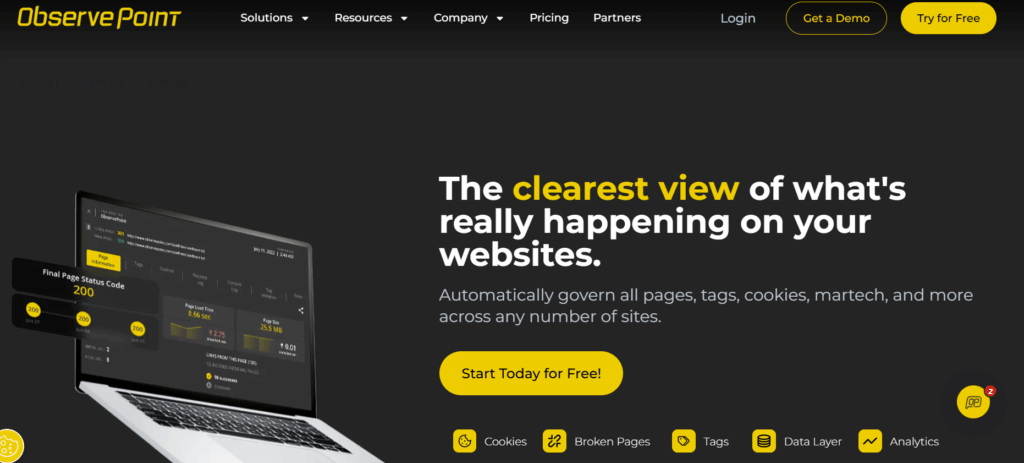
ObservePoint isn’t a tag manager you use to fire tags. Instead, it audits what’s already there. It scans your digital properties to verify tag deployment, cookie behavior, data layer integrity, consent enforcement, and more.
ObservePoint is built for teams that want validation that their tagging ecosystem is accurate, privacy-compliant, and operating as intended.
Key features
- Site-wide audits: Scan tags, cookies, analytics deployments, and content across pages to help ensure nothing is missed.
- Consent and privacy validation: Confirm that consent banners and policies are present and behaving as expected across scenarios.
- Simulations and alerts: Run user-state simulations (e.g. consent granted/denied) and alerts on discrepancies or broken tags.
- Performance and workflow insights: Check page load times, broken links, email paths, journey flows, and other experience signals.
Pricing
Free trial: For up to 1,000 pages scanned, no credit card required.
Volume-based paid plans: Annual pricing scales with the number of page scans. The ObservePoint website offers a pricing calculator.
| Pros | Cons |
| Free initial scans make testing easy | Doesn’t manage tags, only audits them |
| Great for quality assurance and governance teams | Not a substitute for an actual tag deployment tool |
Ingest IQ
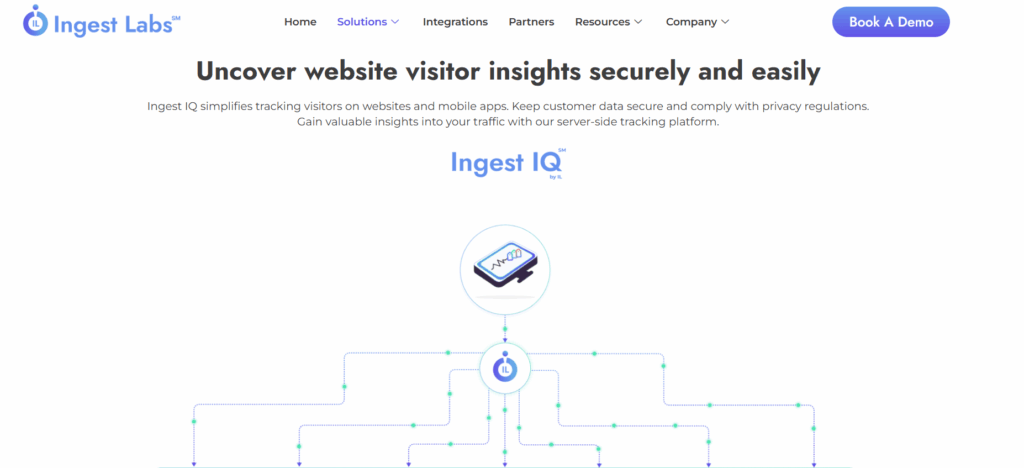
Ingest IQ is a server-side tag management system that helps businesses centralize, validate, and govern their tracking tags.
Unlike traditional browser-based tag managers, Ingest IQ processes data server-side rather than client-side, which improves accuracy, reduces the impact of ad blockers, and speeds up websites.
Teams can deploy, monitor, and debug tags from one interface while ensuring they only fire in line with privacy rules.
Ingest IQ is often chosen by enterprise-level companies that need high-volume, privacy-compliant, and performance-safe tag operations.
Key features
- Server-side tag deployment: Tags are fired from the server instead of the browser, which improves measurement reliability and reduces site performance impact.
- Centralized management: Manage all tags for web and mobile apps in one platform, with built-in workflows for publishing and governance.
- Monitoring and debugging: Real-time alerts and debugging tools keep tags firing correctly and verify the accuracy of data payloads before they’re pushed downstream.
- Consent and compliance controls: Tags can be configured to respect user permissions automatically, with audit logs for regulatory reporting.
- Integrations and streaming: Send collected data directly to analytics, CDPs, and marketing platforms in real time, avoiding duplication or data loss.
Pricing
Pricing is not publicly listed. Ingest IQ provides custom enterprise pricing based on traffic volume and implementation needs. Interested customers must request a demo or quote directly.
| Pros | Cons |
| Server-side deployment improves accuracy and performance | No free plan or transparent pricing available |
| Combines tag management with compliance and governance | Excessive for small-scale tag management |
| Real-time monitoring and debugging tools | Requires Amazon Web Services (AWS) infrastructure and expertise |
TagCommander
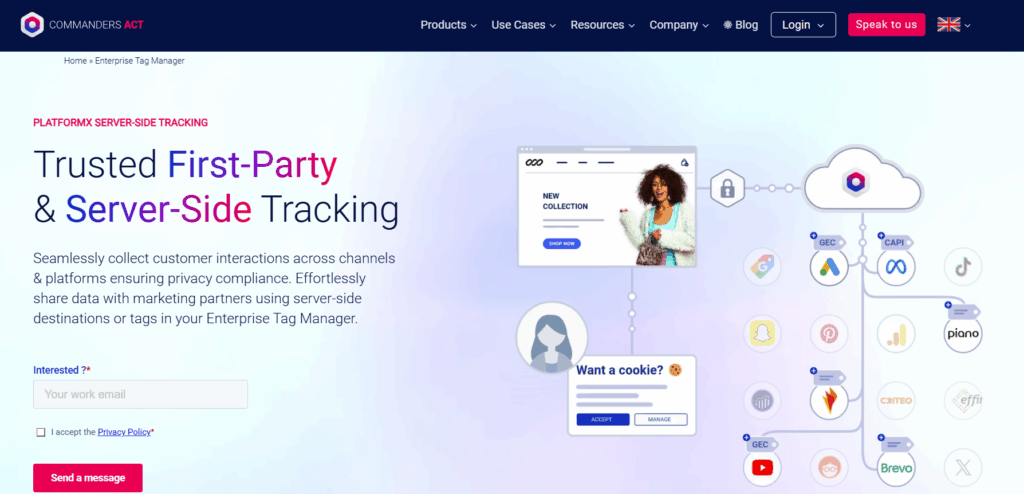
TagCommander is part of the Commanders Act suite, which is focused on data governance and customer journey optimization.
Its tag management system provides marketers with flexibility to deploy and update tags. But its real strength is in how it fits into a larger ecosystem of consent, data collection, and activation tools.
Key features
- Flexible tag deployment: Manage analytics, advertising, and affiliate tags without touching site code.
- Privacy and compliance ready: Integration with Commanders Act’s Consent Management Platform supports privacy compliance.
- Data activation: Connects collected data directly into Commanders Act’s CDP for segmentation and activation.
- Cross-device functionality: Helps maintain consistent tracking across channels and devices.
Pricing
The pricing for TagCommander is not listed publicly. TagCommander is available as part of the Commanders Act platform.
| Pros | Cons |
| Integrated with full data governance and CDP stack | Limited visibility into standalone pricing |
| Strong compliance and consent features | Ecosystem approach may be too broad for basic needs |
| Good fit for omnichannel data activation |
Yottaa
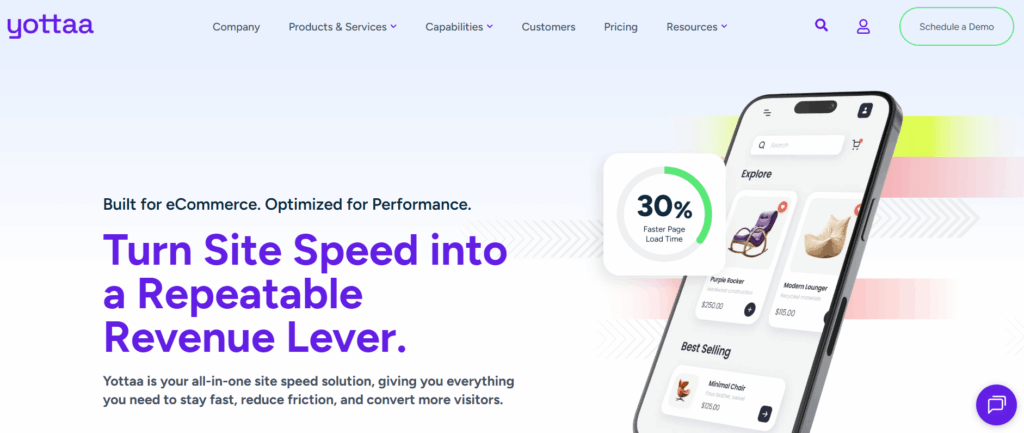
Yottaa is not a tagging solution in the traditional sense. It’s a web performance and optimization platform that includes tag governance as part of its offering. Its focus is on improving site speed and user experience by managing how and when third-party tags load. It’s particularly appealing for e-commerce companies, where slow pages directly impact conversion rates.
Key features
- Third-party tag control: Teams decide which tags load, when they load, and under what conditions.
- Performance optimization: Acceleration techniques reduce latency from heavy third-party scripts.
- Security and compliance: The platform helps ensure tags don’t violate privacy or performance standards.
- Analytics dashboards: Visibility into which tags slow down site performance and how they impact user journeys can help you make informed decisions.
Pricing
- Yottaa offers a free plan with limited features available
- Paid plans range from USD 12,000/year to USD 120,000/year
| Pros | Cons |
| Improves site performance | Not a full-featured TMS |
| Strong fit for e-commerce sites | Pricing and details not publicly transparent |
| Adds security and compliance monitoring | Narrower scope than broader tag managers |
How to pick the right tag management platform for your business?
To choose a tag management platform, you’ll first need to be clear on your current needs and growth plans. Once you know where you are and where you’re headed, it’s easier to weigh your technology stack, regulatory obligations, and your team’s capabilities against what the different platforms offer.
Your existing ecosystem is often the deciding factor. If you’re already invested in Google’s marketing tools, Google Tag Manager is a natural fit. Adobe customers tend to get more value from Launch thanks to its tight platform integration. For organizations that put regulatory compliance and data privacy at the center, Piwik PRO stands out with its dedicated privacy features.
Cost is another key consideration. Free tools like GTM cover most day-to-day use cases and help teams move fast. But when you need enterprise-level features, you might need to invest in a paid platform. If you do, don’t just look at the license fee. Factor in implementation, training, and ongoing management to get a realistic picture of total cost.
Enterprise tag management vs. basic tagging solutions
As you consider whether you need enterprise tag management or if basic tagging solutions are enough, scale may be the deciding factor.
Enterprise systems bring advanced governance, compliance automation, and performance controls that basic solutions don’t. Large organizations often rely on approval workflows, audit trails, and role-based permissions to keep oversight tight.
By contrast, basic platforms like GTM are designed for speed and simplicity. They’re powerful enough for smaller teams, especially when the goal is to cover marketing use cases without adding unnecessary complexity.
In the end, it’s not about which tool is “best” overall; it’s about what’s best for your situation. If you manage multiple brands, operate across different regulatory jurisdictions, or need detailed compliance reporting, enterprise solutions will serve you more effectively. But if your needs are more straightforward, a streamlined option like GTM could be the smarter choice.
Making tag management systems work for your business
Managing tags manually slows down marketing teams and creates maintenance and privacy compliance headaches. Tag management systems help solve both problems by giving you control over tracking deployment while automatically enforcing privacy rules.
Ultimately, your choice depends on the size of your team, technical requirements, and budget. Free options work well for basic needs, while enterprise solutions provide advanced governance and privacy compliance features.
No matter what you choose, investing in tag management pays off through faster deployments, better site performance, and simplified privacy compliance.
